Text
One with the Cow


Garo 1983 August issue with cover art by King Terry/Landscape with Cows cover page
At no point in my reading journey would I have expected to read such a compelling story that intertwined identity and cows so seamlessly. And no, they're not separable. The two work hand in hand to open my eyes to such an expressive and unique style of storytelling.
The story in question is Kanno Osamu's "Ushi no iru Fuukei" (The Landscape with Cows) from Garo. There isn't too much info on Kanno that I personally could find, but he had debuted in Yagyo in 1973 and has published works in a few other magazines mainly in the 70s and 80s. Currently, he's serialising his "Meshia no Umi" (The Sea of the Messiah) series in AX, with the most recent issue at this current date (vol 154) including its 66th chapter. His style can be traced back to the dreamlike and surreal storytelling of gekiga greats like Hayashi Seiichi and Tsuge Yoshiharu. Those two mangaka are cited as his inspirations, but other mangaka that have styles along the same vein also include Abe Shinichi and Oji Suzuki (for those who are curious for more). With Garo, I've been exposed to a wide variety of amazing artists and stories, but "The Landscape with Cows" is one of the best one-shots I've read so far from this magazine.
Neurosis?
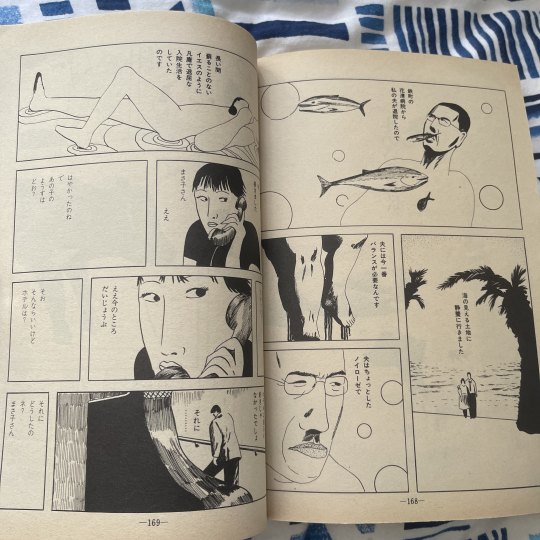

Our story begins with our narrator Masako calling her mother-in-law on the phone to update her on her son. Masako's husband had recently been discharged from the hospital for a case of neurosis after he had sent some concerning letters to his parents. They're currently staying at a hotel near a beach as he recovers, but something interesting about the location is its abundance of cows. Masako thinks that maybe it could be a tourist attraction, but also that they look visually off-putting to her.
"[The cows are] kind of grotesque aren't they."
She assures her mother-in-law over the phone that all is well with her husband. The mother is quite over-worried and anxious, an overly protective parent. We never get to see what the mother looks like, but it's quite clear that she's being a bit of a handful with her check-ups.
Right after the first four pages, Kanno shows a strange scene of the husband naked, bending over and making cow noises with 'horns' attached to his head.


"That time, when I looked into his eyes, I was speechless"
Masako recounts her experience seeing her husband in this strange position. She also reveals that she always knew her husband was gay and that his love for her was never true. In the background, a giant dinosaur looms, very reminiscent of Oji Suzuki's surreal gekiga style. I am incredibly in love with this characteristic seen in gekiga frequently: seemingly random placements of objects that make the story's atmosphere extremely mysterious and reflective.

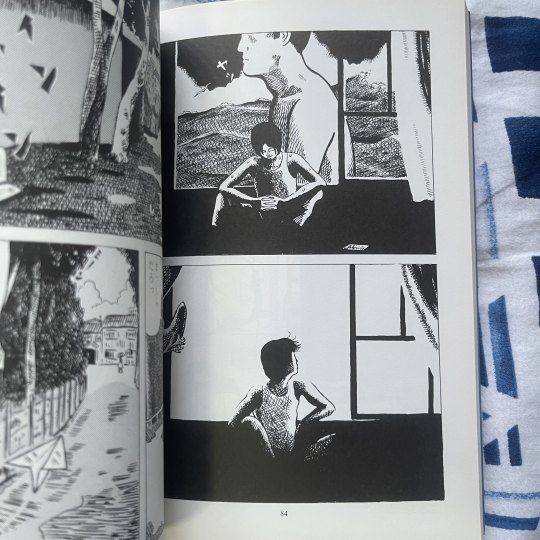
Various panels from Oji Suzuki's 'Motorbike Girl' tankobon
Cows Over Humans
Masako's mother-in-law continues to ask her to take care of her son, this time expressing that she's scared of him taking his own life. But Masako thinks to herself that it might be something different:
"I don't think he's thinking about killing himself. I think it's that he wants to be reborn as a cow after dying."
This line is such an interesting one to think about. Coupled with the ominous imagery, especially the panel with his head being that of a cow, you wonder about what it is about bovines that appeal to the husband. Or, maybe you're not supposed to know. The way that Kanno depicts the husband's obsession doesn't put it down and merely just treats it as just another way of thinking, another belief or worldview that anyone can have. It's especially made apparent when Masako starts reassuring her mother-in-law about the contents of her husband's letter:
"What he said about cows being better than people is wrong. Isn't that right, mum."

On this page, what follows Masako's line are panels of random people with words like famine, culture, disease, and pretty much any human concept/idea/issue that exists. These examples contradict what Masako is saying on the phone, and shows that her husband might be right in saying that cows are better than humans after all. His mum can be representative of those who can't understand the sensibilities of people with different worldviews or beliefs, which I think plays out quite well with Masako being in the middle of all this. Her relationship with both mother and son gives her a unique perspective, and hence narration, on her husband's 'neurosis'. She has to assure that everything is okay for the worried mother, but also has to internalise the thoughts she has about her husband's true situation.

"Cows don't fight. They aren't dishonest like humans are."
So what is wrong with wanting to be a cow? They don't fight, they aren't corrupt or start wars or anything like that. They are simple creatures devoid of any worries other than their survival. Masako's line about dishonesty is ironic considering how she'd lied to her mother-in-law over the call. What the quote says to me is that Masako is fed up with having to put on an appearance to her in-law. She has to lie and assure her that everything is okay, but all of that can be such a chore. Which comes back to the point that I believe Kanno could be conveying: what's wrong with wanting to be a cow? What's wrong with wanting to be free from human flaws?
This thought process I have with what Kanno could possibly be trying to say brings me back to Tsuge Yoshiharu's "The Incident at Nishibeta Village", which follows a village's hunt for a man who had 'escaped' the sanatorium. Though, when we do encounter the escapee, he doesn't seem as crazy or violent as the villagers make him out to be. That clash between the man and the rest of the villagers is quite similar to this situation with the husband and his mum. Is he as crazy or suicidal as she thinks he is? Doesn't seem like it from the way Kanno depicts him.

Tsuge Yoshiharu's "The Incident at Nishibeta Village" - taken from Tom Gill's article in the Asia-Pacific Journal
The way this story progresses points more and more towards the husband's desire being something that is normal. He may be judged on the outside by those who don't know him well, that being his mum in this case. But for those who do understand him, that being Masako, they can understand where he is coming from and why his desires aren't so outrageous. The husband's neurosis and the duality of how its perceived by others is such an interesting topic that really makes the cow imagery natural to the story.

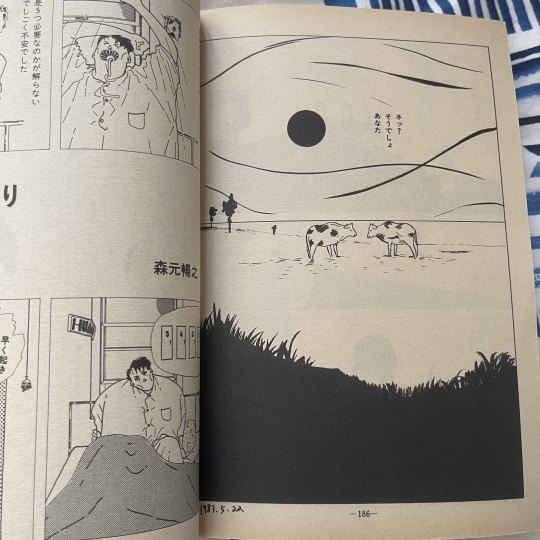
At the end of the story, Masako continues to voice her thoughts through the narration.
"If he wants to be a cow, then be a cow. That person will still always be my husband. Isn't that right, you?"
Here, this last section of dialogue is Masako expressing her views on her husband's situation. It's a confirmation that she doesn't view the desire as negatively as his mother. There could also be a hint of jealousy in her with how she has deal with the over-protective parent. Her husband doesn't have to worry about these trivial things. Living in bliss, no matter the form, is living in bliss. It doesn't matter if you want to be a cow or anything else. The husband is in a state of bliss that is impenetrable by human worries and concerns.
Final Thoughts
Kanno Osamu is a mangaka that I really want to read more from, but his tankobons are quite hard to find. "The Landscape with Cows" was my first exposure to him and reinforced what I love about gekiga. As I had mentioned before, other mangaka like Hayashi Seiichi, Oji Suzuki and Abe Shinichi all have similar styles in storytelling. They are mysterious in the way they depict characters and settings, oftentimes placing seemingly random panels and objects throughout their narratives. What draws me the most to their works is the atmosphere, one that I think is quite unique to Japanese artists and mangaka. One of my favourite books, "Almost Transparent Blue" by Ryu Murakami, also gives off the same tone as a lot of gekiga. Their stories are about people getting by, wanting to escape from the world to live in bliss, unconcerned about wars, careers, relationships and the future in general. With this story by Kanno, it pretty much says the same thing. What is wrong with wanting to be free? If you want to be a cow, so be it. It's a normal desire to have, no matter what form it may manifest in. Legendary short story in my opinion, one of my favourites from Garo.
Thanks for reading!
2 notes
·
View notes
Text
Worshipping Flesh
Quite the confronting title, I know. But I don't use the terms "worshipping" and "flesh" lightly. You can probably guess that this post will be about a mangaka in the ero-guro (erotic-grotesque) scene, a world that is both filthy and alluring in its subject matter and visual storytelling.

Double page spread from Hanawa Kazuichi's "Moonlight" tankobon
Hanawa Kazuichi is an infamous ero-guro mangaka known for his Japanese period pieces, debuting in Garo in 1971. His stories frequently feature extremely confronting sexual and violent imagery, many focusing on the decadence of the upper-class. He's up there with Maruo Suehiro as being one of the most recognisable faces of the ero-guro manga movement, with each iconic mangaka standing out in their own ways. They've even collaborated on an artbook called "Muzane" (Cruel Pictures), imitating the "28 Famous Murders" series done by Yoshiiku and Yoshitoshi, two Ukiyo-e masters. When I think ero-guro, my mind always goes to Maruo and Hanawa for their insanely detailed drawings and raw stories.
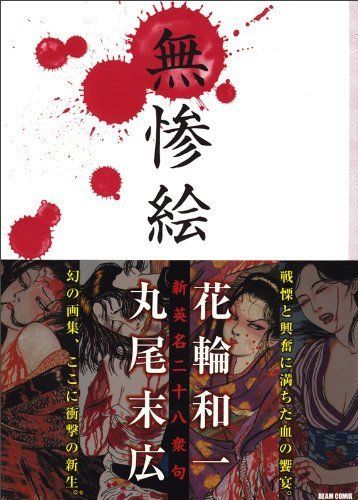
"28 Scenes of Murder" by Maruo Suehiro and Hanawa Kazuichi
Although, Hanawa has quite some range because he's also done some fantasy and supernatural works along with his iconic ero-guro. One of his most well known series that won multiple awards is titled "Keimusha no Naka" (Doing Time), and was published in English by Ponent Mon in 2006. It's an autobiographical story of his time in prison for his possession of illegal firearms, a sentence that lasted for 3 years. Once he got out of jail, he started serialising in AX and gained recognition for his compelling story.

Garo 1973 June Issue with cover art by Hanawa Kazuichi
A Blossoming Love
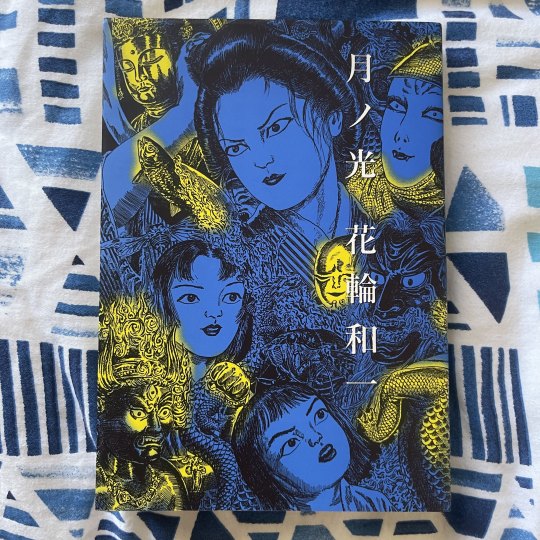
Coming back to the whole idea of the "worshipping of flesh", I want to talk about one of his short stories in his "Tsuki no Hikari" (Moonlight) collection. The edition I have collects 9 stories from his career in a beautiful deep blue tankobon, mainly made up of ero-guro with some other types of stories sprinkled in. The story in question is titled "The Tabernacle of Flesh". What a name.
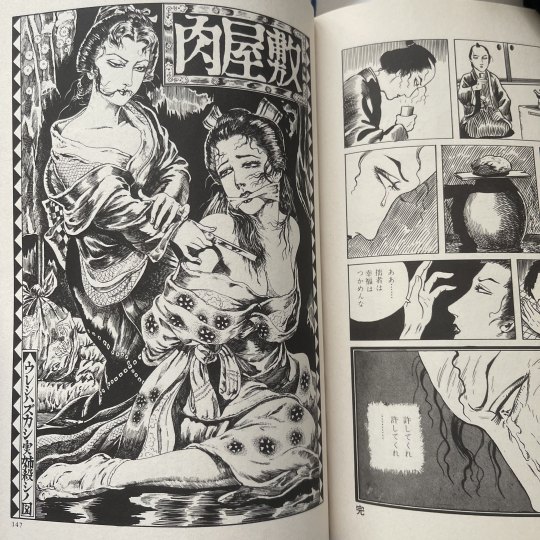
Opening page of "The Tabernacle of Flesh"
To reference Merriam-Webster for some definitions, a tabernacle is:
"a house of worship/specifically: a large building or tent used for evangelist services"
There are other definitions of it in the context of the Bible, but I personally don't know enough about the religious background of this word so I'll be using the general definition above. The story itself doesn't touch upon any religious topics either, so equating the word with "a house of worship" should suffice.
So with such an in-your-face title, what could the story actually be about? In terms of Hanawa's works, "The Tabernacle of Flesh" lines up very closely with his other distinct period pieces, with many centred on love, betrayal and violence. The story opens up with our main character Orin, a woman recounting the time her friend Gyakujiro had organised an arranged marriage for her with Momohiko. This story had happened 3 years ago, so the chapter is essentially the main character's confession to the reader. She had to take care of the sickly Momohiko constantly as he suffered from an unknown disease that left him bedridden. As we get settled into the story with Orin's narration, we're given a line on the fourth page that spells out the imminent doom she would be getting into.
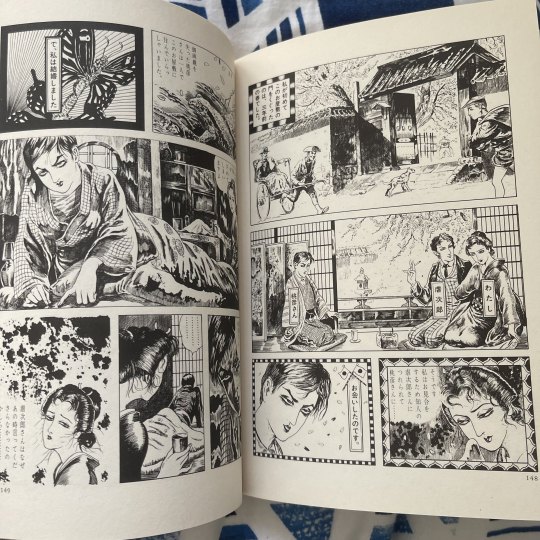
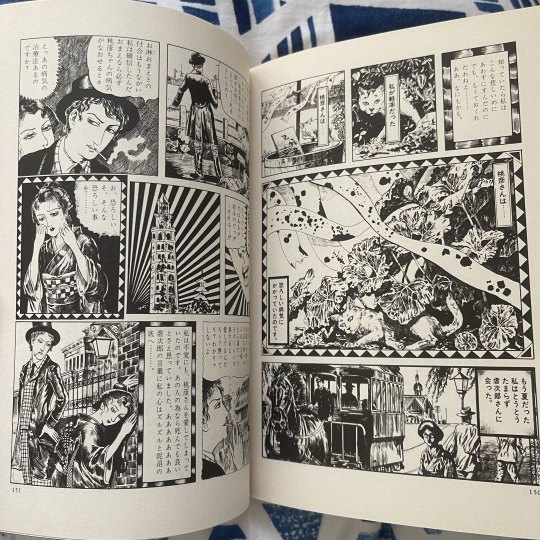
"If I had known what was to happen to me, I wouldn't have done it. And now it was too late." - Orin
Over time, Orin had developed genuine feelings for Momohiko. Maybe it was her constant care for him that made her feel this way. She said that at the time, she would have even been fine with dying for him. But besides her love for Momohiko, what plagued her even more was his sickness. Nothing seemed to get better, but Gyakujiro had a secret solution...

The following two pages are brutal. Orin's sister, killed by her own hands. A random schoolboy, slashed in an 'accident'. How could this help Momohiko at all? Gyakujiro doesn't tell her, but Orin does as he says out of her immense love for Momohiko.
"Killing one person is the same as killing two or five or a hundred." - Gyakujiro
Orin continues to lure and kill more innocent people, hiding their bodies around the house. Flesh, flesh, flesh. That's all she was told she needed to get, so she continued killing for the sake of her husband.
Betrayal
Time skips to Orin's tenth murder. So far, Momohiko has not been given any dialogue and remains stone-faced throughout the story. When will we get anymore information on what he's going through? Soon enough, after Orin's tenth victim, she had spotted a suggestive silhouette on a wall. She realised that Gyakujiro and Momohiko were in love. Getting Orin to kill all these people was Gyakujiro's plan to save Momohiko from his disease because the cure was apparently human flesh. It seems like the disease is one that is somewhat supernatural/fantastical, which you can see from the various bloody holes scattered across Momohiko's body. They spewed blood, implying that Momohiko needed other people's flesh to substitute for his own, his body somehow lacking the flesh needed to contain his blood.

"Gyakujiro, I've had enough of this life as a fake couple. I can no longer stand the stench of that dumb hag's hair..." - Momohiko
"A little patience, my little Momohiko. Soon, you'll be completely healed. Then we can get rid of her and live happily together. Until then, let's be careful and let her continue her crimes. You require human flesh. It is the only remedy for your illness." - Gyakujiro
The Climax
After witnessing this heart breaking scene, Orin took her chance to strike. We immediately cut to the situation later that night, and are given some insight into her mental state:
"As I'm running out of pages, here's what happened: that same evening, I slaughtered them in their sleep. I took a razor made in Germany and spilled buckets of their blood. They died on the spot. Serves them right! Hi hi hi!" - Orin
Her rage had consumed her and resulted in the bloody deaths of both men. But the story doesn't end there. Still unsatisfied after killing both of them, Orin decided to cut off the flesh from Momohiko's behind and eat it. The obsession with flesh transitioned from being motivated to protect Momohiko to being driven by hatred. The house truly became a 'tabernacle' over time. Everything had to do with flesh, in all senses of the word. Flesh as in human meat, flesh with a sexual insinuation, flesh as sustenance. The house that the story was based in was literally littered with flesh as Orin's victims decomposed in the background, waiting to be used by Momohiko. We're never shown what he actually did with the bodies, but from Orin's actions at the end of the story, we can assume that it was also cannibalistic in nature.
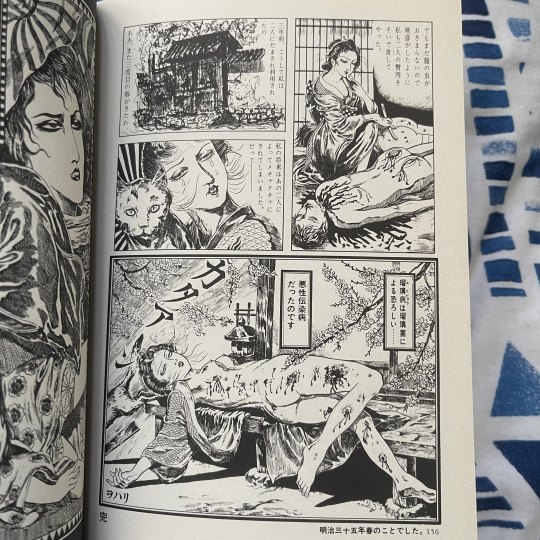
"For three years I had let these two men manipulate me. My life has been completely destroyed/Since the Lapis Lazuli disease caused by the Lapis bacteria, is contagious." - Orin's final lines
After everything she had to go through, Orin had died from the same disease that Momohiko had: the mysterious Lapis Lazuli disease. On the bottom right corner of the ending page, a note states that it was an incident that happened in the Spring of 1902. This fictitious disease had spread from Momohiko to Orin, which you can see from the same bloody holes that are all over her body, limp in a dramatic pose.
Hanawa's drawings really elevate the experience of reading this story. It reads like a theatre production, with the narration and dramatic poses giving you the feeling of watching a play. The transition from love to pure hatred, coupled with the insane and climactic consumption of flesh by Orin, was intense and raw. The drama and tension remained high throughout the entire story. With the plot being completely driven by flesh for all characters, you're left feeling both disgusted and enraptured, a telling sign of a strong ero-guro story.
Borders
To end off this post, I want to put a spotlight on Hanawa's art, specifically the way he experiments with borders and backgrounds.
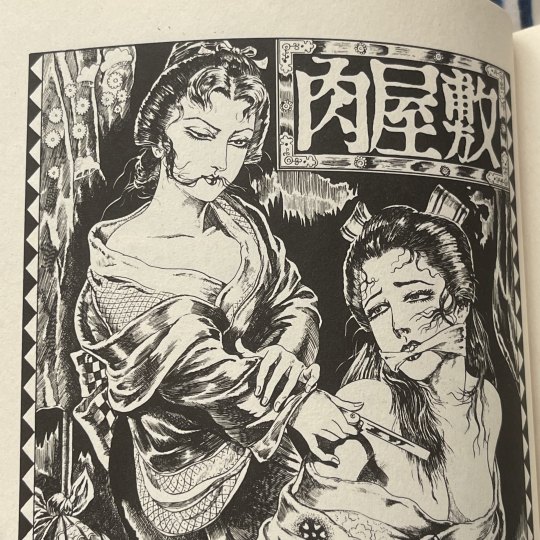

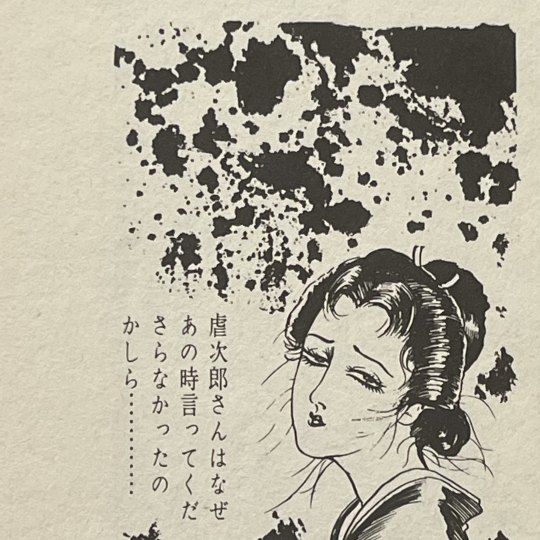
I've never seen this sort of experimentation before in manga. His panel borders are incredibly diverse and make the central visual pop. I feel it also adds to the theatre-like nature of his stories, dramatising the panel and heightening its impact. This is even more so with the expressive ukiyo-e styled character designs in a lot of his works, each panel pretty much a painting in itself.
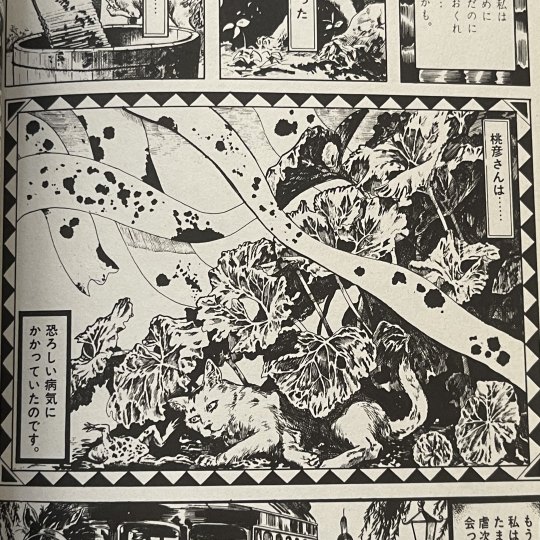
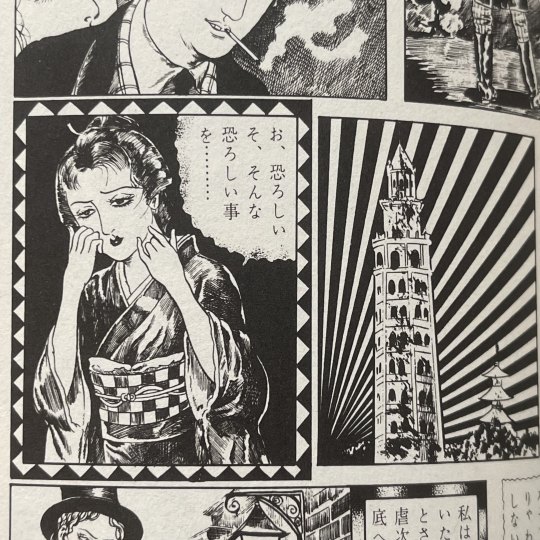
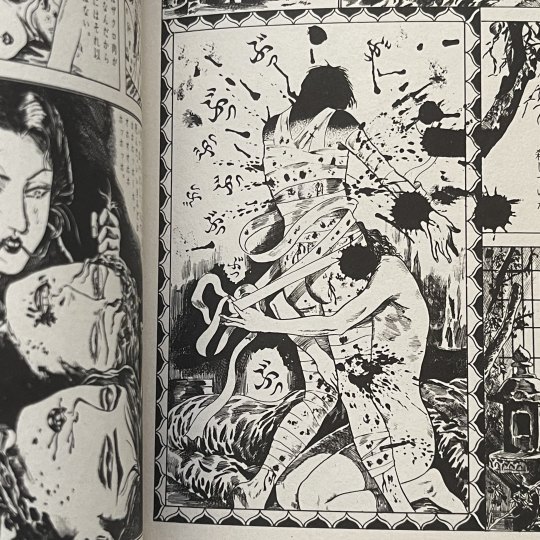
His backgrounds as well give all his pages such a strong aesthetic where you'll pretty much recognise his work just by seeing these pictures. The story itself is quite straightforward, but I think that the main appeal of "The Tabernacle of Flesh" is the shock factor, all supported by these unique artistic choices Hanawa is making. I wanted to point this out so more people could appreciate uniqueness like this in manga.
As a bonus, below is a picture of a poster that Le Dernier Cri put out. I'm extremely sad that this is sold out, but it's an old one that was printed years ago. But thanks for reading! Loved writing about this one, more people need to know about Hanawa.
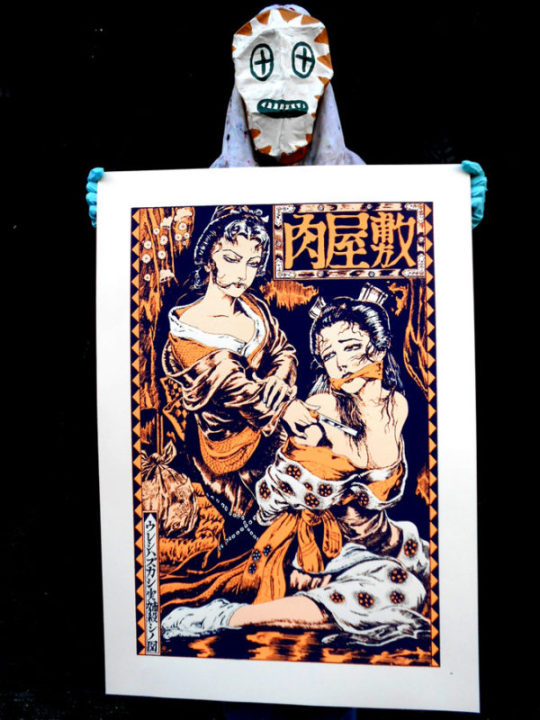
Photo credits to Le Dernier Cri
1 note
·
View note
Text
Prophecy of the Kudan
"Goshiki no Fune', or "The Five-Coloured Boat", is a novel written by Tsuhara Yasumi that was adapted by Kondou Youko into a manga in 2013. Note that I haven't read the original book, so I'll be going off the afterword from the manga when I talk about key differences between both versions.

This was my very first exposure to anything Kondou. The manga is a perfect introduction to her authentic and heartfelt human dramas, all having some degree of relatability for any reader out there. No matter what you've experienced, she has a story to tell that will hit you deeply. In this case, with the original story being written by Tsuhara, you can see Kondou's ability to translate and adapt the novel into a medium that is able to freshly reshape the story. As she mentions in the afterword of this book, she had taken some creative freedoms with how certain characters from the original story were portrayed. There are small differences here and there with Tsuhara's story, but her changes are intended to smoothly transition the written story to one that can be consumed visually.
The main reason I wanted to write a post on this manga was because of the distinct plot point of the Kudan, a yokai typically identified as being a cow with a human's face. Sometimes, there are cases of it being the other way around with a human's body, but the creature is mainly known for its prophetic ability. Whatever it says will come true, which plays an extremely important role in 'Goshiki no Fune'. Here's some other sources that provide a summary on the yokai:
At least on the English side, I couldn't find as much information on the Kudan as I would have liked, but what's out there will give you a good enough idea of the creature.
The Troupe
Moving back to "Goshiki no Fune", the story follows a group of people who are apart of a freak show, helping each other survive as they live with their disabilities. For simplicity's sake, I'll be referring to them as the family throughout the post. Here's a brief description of the cast below:
Papa: the leader and creator of the troupe. He was a renowned actor that had to have both of his legs cut off because of gangrene
Shousuke: a dwarf that was found at a riverbank by Papa who acts as a strongman in shows
Kiyoko: a woman born with knees that bend backwards who is presented as a 'cow woman'
Sakura: a girl who was born as a Siamese twin and was successfully separated from her sister. She can't speak but can hear, and acts as a 'snake girl'
Kazuo: a boy born with deformed arms who is our main character. He can't speak nor hear but can still understand people, and paints with his feet in the troupe

Shousuke pulling Papa and Kiyoko on a cart while Kazuo and Sakura walk behind
The beginning of this manga is an important one because it introduces a core idea that will be revisited towards the end of the story:
"Once I die and depart this world, my heart will return there once more/Back to that many coloured, tattered, lovely little boat."

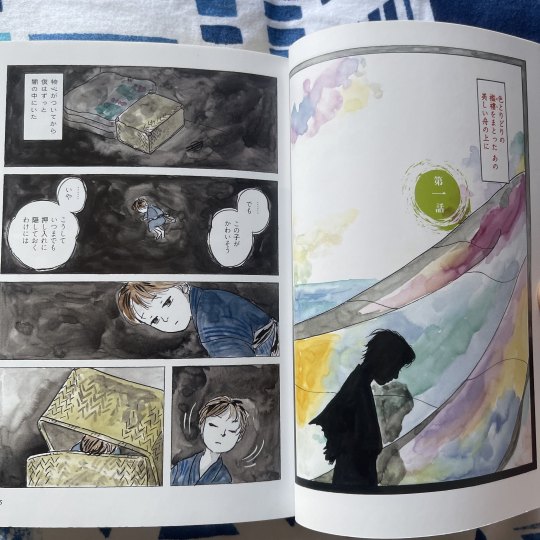

The line above is narrated by Kazuo as we get a colourful view of the sea and the boat in question floating in the middle. We're introduced to Kazuo as he stares in awe at the boat the family lives in. The towering shadow of the boat is the first thing he encounters as he climbs out of a straw box, and he recognises that it signals the start of a new world for him. We can gather that he had been abandoned by his parents because of his disability, floating down the river until his box had washed up on the shore. Quite a sad start to the story already, even without yet knowing about his disabilities and struggles.
As the story progresses, we get to learn more about the origins of the family and how each person had been discovered by Papa. What is incredibly important, however, is Papa's motivation. The family is travelling to Iwakuni, the location where the supposed Kudan is kept in captivity. He explains the ability of the Kudan to predict the future and voices his determination to add the Kudan to the troupe's show. He believes that people will pay big money to hear their futures, and rightfully so. However, a condition not mentioned in the story is how the Kudan usually dies soon after giving a prophecy. This information was taken from the sites that I provided above that detail the Kudan's abilities that aren't explained in the manga, but it's an interesting point to note because it foreshadows some of the events that transpire later in the story. So, if you were familiar beforehand with the Kudan and knew about this condition to its prophecies, you would be able to figure out the general trajectory of the story earlier than the character's themselves.

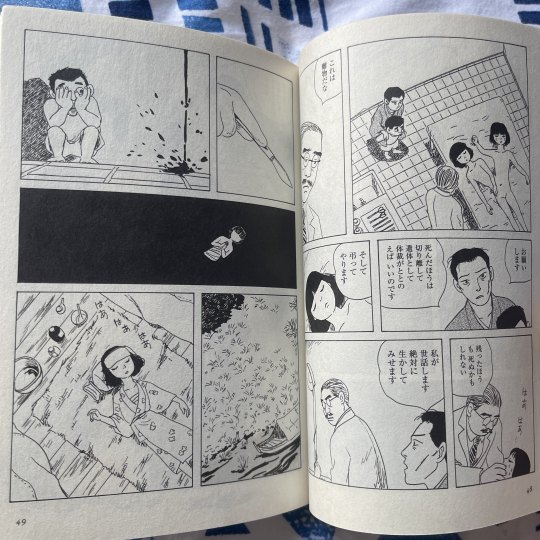


Various scenes of the family's show
The War
What's also interesting to note at this point in the story is the setting. The family are travelling through villages and towns in rural areas, but the second world war is being fought in the background as they put on their shows. We aren't given any dates or any visuals of the fighting, but the story is set somewhere towards the end of WW2, a timeline that becomes more apparent later on. Kondou does show the presence of soldiers scattered throughout the beginning of the manga to hint at this contextual period, but everything begins to escalate once we find out that the army is holding the Kudan.

Kazuo and Sakura get a glimpse of the Kudan in the truck
The pages above mark the turning point of the story. Kondou depicts it in such a quiet and subtle way, making it very easy for readers to actually dismiss these important pages. The scribbles in the speech bubbles is the Kudan talking, and we're shown that both Kazuo and Sakura had taken a small glimpse of the Kudan in the back of the truck and heard its voice (top left panels of the picture). Nothing major immediately happens after this encounter, but we begin to see the effects of the Kudan on Kazuo and Sakura gradually.
Dejected after realising that the army's control of the Kudan meant that he wouldn't be able to use it for his show, Papa sets up camp near a shore. The family continue to put on their shows, but Papa is also trying to find another way to reach the Kudan. The doctor who had amputated his legs and who also saved Sakura, Inukai, is actually Papa's fan and lover. He helps Papa by sneaking him and the family into the facility where the Kudan is kept, bringing us to the climax of the story.
The Dream
Before I talk about the climax, we need to firstly look at what actually happens to Kazuo and Sakura after their encounter with the Kudan. Signs begin to surface when Kazuo starts to dream of the family's boat floating in the middle of the vast ocean. Another boat would appear out of nowhere, and Kazuo would have to watch in despair as each of the family members volunteer to join the other boat, leaving him behind.


Kazuo's sad dream/Kazuo's and Sakura's conversation
We also learn that despite both of them being unable to speak, Kazuo and Sakura can somehow communicate with each other. This method of conversing is unique to them because of their disabilities, so none of the other family members can understand them. Sakura, out of the blue, asks:
"Kazuo-san, is Papa going to get on another boat?"
This comes as a shock to both Kazuo and the reader as we realise that she had been having the same dreams as him. They quickly learn that because they had seen and heard the Kudan, both have been affected by the same dream. If we think back to the Kudan's prophetic abilities, it's inferred that the dream is some vision of the future. And now, with this knowledge of the prophetic dream that's affecting both children, we'll see how the climax with the Kudan plays out.
The Kudan's End
After being snuck into the army facility holding the Kudan, the family talk with it and learn of its prophecy: that Japan would be hit by an atomic bomb and lose the war. Whilst the Kudan explains all of this, it also gives another couple of predictions:
The Kudan itself would be killed soon
The first person to die out of them would be Dr Inukai, followed by the soldier, then Kazuo and Sakura in the atomic bomb
The soldier stationed with the Kudan is planning to kill it because he thinks that it's trying to deceive them. Shortly after explaining everything it needs to explain, the events play out as it had predicted. The Kudan is shot in the head by the soldier, who also kills Dr Inukai. Shousuke manages to kill the soldier but the Kudan doesn't have much time left before it dies. It asks the family for any requests they may have, to which they all express their desire for Kazuo and Sakura to have a better life, to be transported to a better world.
"To what sort of world shall I take them?" - Kudan
"A world where Kazuo can go to school!" - Kiyoko
"A world where they can both live happy lives." - Papa
"A world where all of us can be happy!" - Sakura


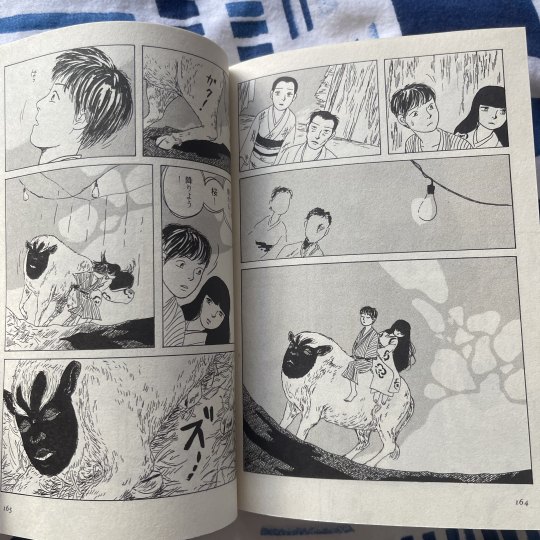


However, after hopping on the Kudan, it falls and dies. What is predicted by Kudan happens, and Japan lose the war. A really notable part about this climactic scene is the ability of the Kudan to transport people into different worlds or timelines. The Kudan itself describes it with an analogy of moving from boat to boat, with the boat representing these timelines. It's an ability that I didn't see anywhere in my research of the Kudan, so this is something that was most likely added by Tsuhara himself and isn't canonical to the yokai. Though, it plays an insanely important role to the ending of the story and how the reader may interpret it.
The Rebirth



After the war, the family begins to see success and stability in their lives. With the technology of artificial limbs, both Kiyoko and Papa are able to walk again. Kiyoko becomes a celebrity and Papa returns to his rightful place in the theatre. Unfortunately, there wasn't any cure for Shousuke, but that doesn't stop him from becoming a wrestler. For Kazuo and Sakura, they both settle down after attending a school for the deaf, with Kazuo also acquiring some prosthetic arms.
The aftermath of the Kudan's death may seem like a simple one, but there's a deeper layer that we can dig at. Firstly, we need to revisit the Kudan's ability to move between different realities or timelines. It's able to take people and transport them between these timelines, but it died soon after Kazuo and Sakura jumped onto it. However, we also need to note that one of the conditions of the Kudan's prophecies was that it would die soon after giving it. The question now becomes whether it had died from the gunshot wound, or whether it died after transporting Kazuo and Sakura to a better world. Did the Kudan fail to transport the children, or did it do so successfully and then die?
This is a question that both Kazuo and Sakura think about. They remember that Dr Inukai had told Papa that it was a matter of where your heart was, which suggests that the Kudan didn't transport the children to another world. Their hearts still remained in the miserable world that feared the atomic bomb, a world where they had to survive in the freak show. But at the same time, the Kudan very much could have transported them to a different timeline where the atomic bomb was still dropped, but their lives afterwards would still be happy. Afterall, the only condition that was given to the Kudan was that it had to transport the children to a world where they could be happy. In the reality we're in right now with Kazuo and Sakura, the atomic bomb was dropped but they still lived happy lives after. Taking all of this into consideration, it gets you really thinking about the chances of both possibilities, of whether the timeline they're in right now is the original or a new one.
But, at the end of the day, it all doesn't matter to Kazuo and Sakura. Why? We revisit the core idea of the manga, introduced to us in the beginning narration:
"Once I die and depart this world, my heart will return there once more/Back to that many coloured, tattered, lovely little boat."
No matter what timeline they're in, both Kazuo's and Sakura's heart belong to the timeline where they met Papa, Kiyoko and Shousuke. The timeline where they were saved and grew close as family. The timeline where Japan faced an impending doom with the end of the war.


"Our feelings will always remain in that world. That world may be an empty one where everything ended when that bomb fell. But once our fleeting lives here in this world end, we know that our hearts will return there. We will not run away. We will be standing there. On that tattered, multi-coloured, lovely boat." - Kazuo
Final Thoughts
"Goshiki no Fune" is one of the most memorable stories I've read in recent years. The combination of the unique cast, the subtle yet poignant setting and the centrepiece of the Kudan all mix together incredible well. Rereading this manga, and especially writing about this ending, had me very teary-eyed. Kondou does such a great job at pulling at your heartstrings. After following this family and their struggles, all you want to do is root for them and wish for their happiness. In a world where their disabilities limit their mobility, and the looming threat of the atomic bomb towers over Japan, the Kudan became their one hope. And after everything had happened with the passing of the war, it becomes clear that maybe the Kudan wasn't the key to their happiness. Their hearts will always belong in their original world - the same boat - no matter how hard it was to live in.
Thanks for reading! This was an emotional one to write about...
1 note
·
View note
Text
Furuya no Mori: A Japanese Folk Tale
Adapted by Nagashima Shinji

A story of mistaken identity and humorous misunderstandings, 'Furuya no Mori' exhibits the charms of the Japanese folk tale, mixing mischievous intruders with a comedic sequence of events in a mountain village. I was first introduced to this story through one of Nagashima Shinji's folktale adaptations in Garo December 1968. He has a series of these illustrated folk tales throughout the magazine, many of which are my favourites from his body of work. There, his distinctly cute and cartoonish art style brings the folk tale to life, reinvigorating it with a new edge.

Monthly Garo Magazine 1968 December Issue (cover art by Shirato Sanpei)
I'm not entirely sure of the origins of this folktale, but if you want to read up on a translated version of the original, here is a pretty good link.
But to start things off, we're introduced to a bandit who believes he's the best thief out there. Dressed with a conspicuous costume and a goofy expression, the thief stations himself at a house and waits for the best opportunity to snatch the horse. However, we are introduced to a wolf who also wants this same horse, setting himself up in the stable. Both intruders, unaware of each other, wait atop the horse until the inhabitants of the house finally go to sleep where they'll take that chance to strike.

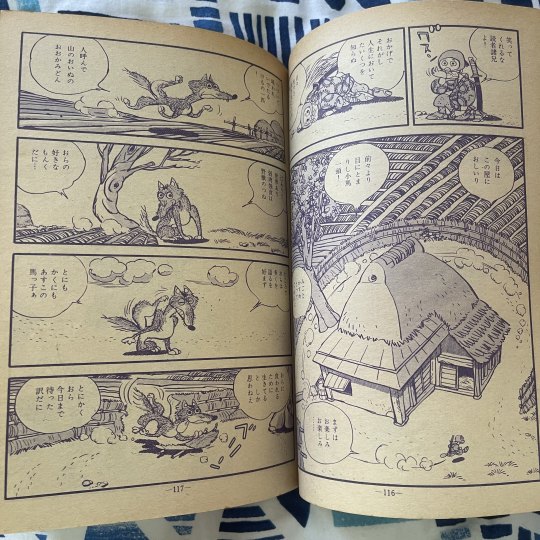
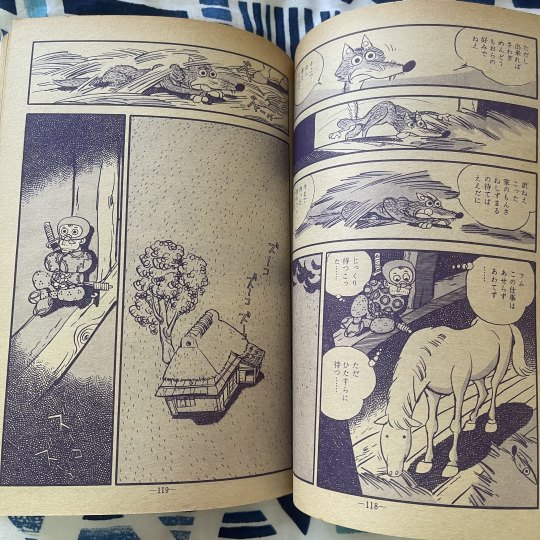
Meanwhile, a boy and his grandparents are eating in the main room, telling stories of things they think are the scariest. The grandma says a bandit is the scariest, making the bandit feel proud of himself. The grandpa disagrees and says that wolves are the scariest, inflating the wolf's ego as well. However, the grandpa thinks of something else that is scarier than both, leaving both the bandit and the wolf anticipating in fear. A 'Furuya no Mori'.

The bandit and wolf wonder what a 'Furuya no Mori' is. They start sweating and shaking, imagining how much of a horror it could be. As they shiver in fear, rain starts to fall and leak through the roof, causing a panic in the main room.
"This is bad!" screams the granpda.
"The Furuya no Mori is here!" shouts the boy.
To explain, 'furuya no mori' translates to a leak in an old house. The bandit and wolf had misunderstood and thought the term referred to an unknown horror that was even scarier than themselves. The two speed away together, with the bandit getting stuck in the inside of a tree and the wolf reporting the horror to the other animals.
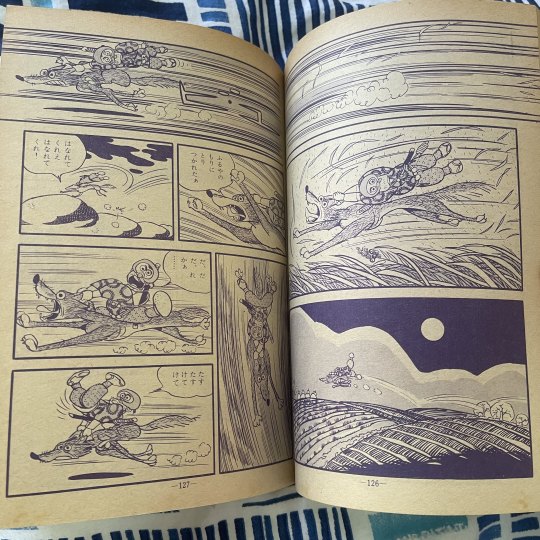
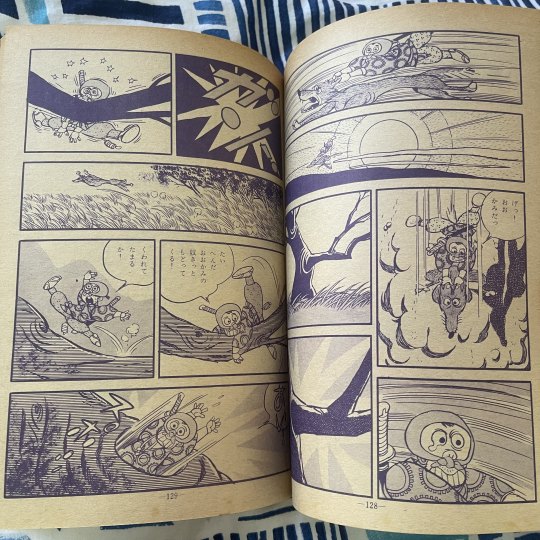
None of the animals had ever heard of this mysterious 'Furuya no Mori' before, so they go and investigate. They dare the monkey to search the inside of a tree with his long tail, but the bandit manages to pull himself out and his tail snaps. From that point on, the monkey was stuck with a short tail and a red face from the shock, a reminder about the 'Furuya no Mori' incident.
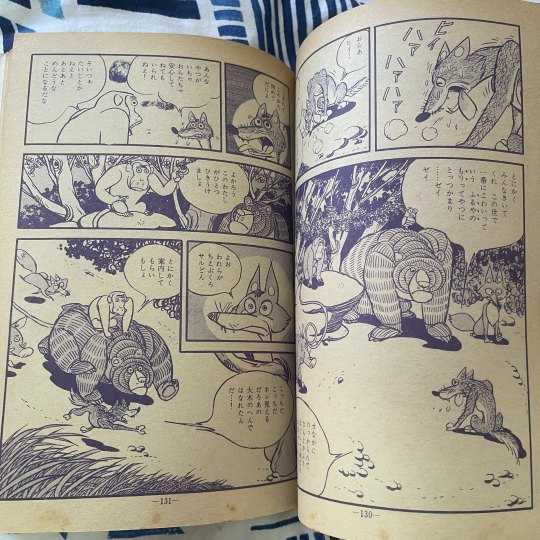

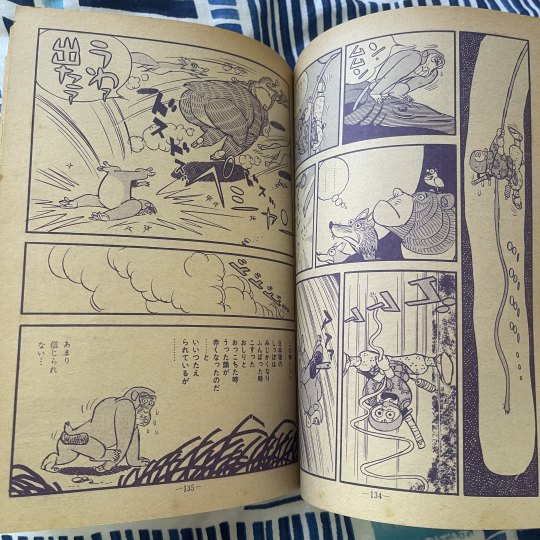
The ending is an interesting one that explains the appearance of the Japanese macaque through the medium of the folk tale, a feature which I really love. It was a pretty simple and straightforward story, made all the better with Nagashima's visual rendition of the tale with cute and expressive character designs. There's plenty more folk tales that he had adapted in his "Dansan Collection" throughout many issues of Garo, so I might make this a series as well. Always fun to learn about different folk tales, so I hope this was an enjoyable read!
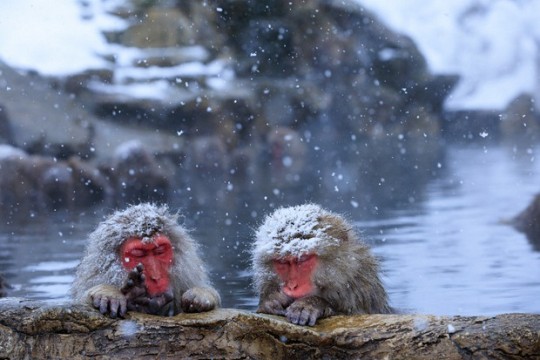
Japanese macaques chilling...
0 notes
Text
Time Loop Stories: As The Sun Sets…
FULL STORY SPOILERS
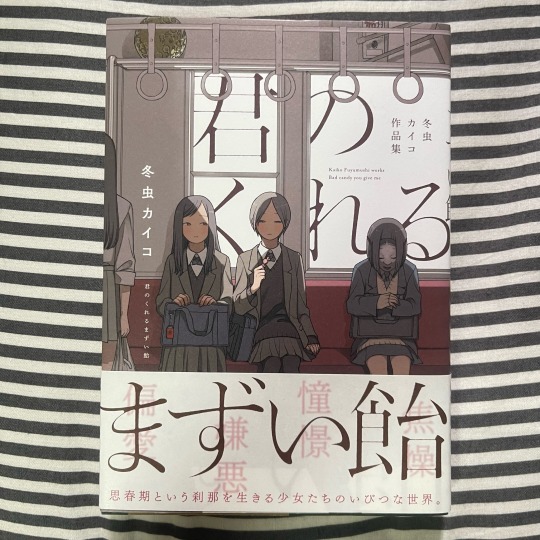
Near the top of my list of being one of the hardest types of narratives to execute tastefully, time loop stories are among my favourite pieces of fiction. It's a difficult structure of story to maintain from start to finish, having to uphold an increasing rate of tension throughout its duration. Over the course of my reading journey, there have been few that have caught my eye. The ones that did still stick with me to this day; they're unforgettable. It's a high barrier of entry that my brain imposes on these types of stories, but any candidates that pass through are immediately stored in my long-term memory for their ability to strike wonder and awe even years after my initial contact with them. The first instalment in this series will be focused on one chapter that I'd encountered in a short story collection this year titled "The Bad Candy You Give Me" (Kimi no Kureru Mazui Ame) by Fuyumushi Kaiko published in 2019. The mangaka had stuck out to me for her distinctly unique use of magical realism, combining her characters' fears and dread with otherworldly depictions of the supernatural and the impossible.
The specific story that I want to spotlight is titled "Sets in the West" (Nishi ni Shizumu). Coming in at only 14 pages, Fuyumushi keeps it short and extremely sweet. These types of time loop stories benefit the most from concise storytelling, where most I've seen never stray for too long.
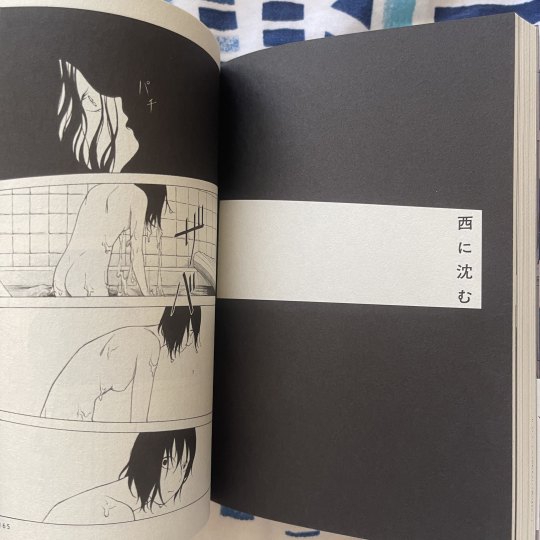
Nishi ni Shizumu: Opening pages
The story begins with a woman rising from a bathtub, eyes wide in fear as she peers over to her right to see another woman who looks exactly like her staring back. Both are stunned and lock eye contact. The doppelganger is frozen and seems to have been opening a carton of chemicals. Upon reanimation, the woman goes to immediately choke her doppelganger until she no longer breathes, recovering her clothes. She narrates her emotions, describing a deeply murderous intent that had seemingly popped out of nowhere.
"I don't need two of me. It's a natural law."
"Like how the sun rises in the east and sets in the west."
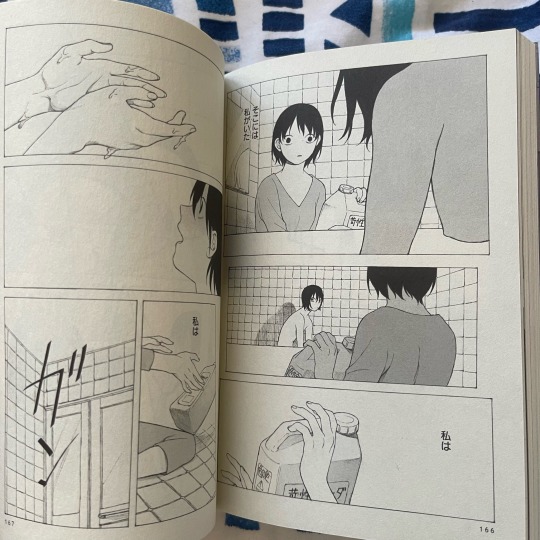
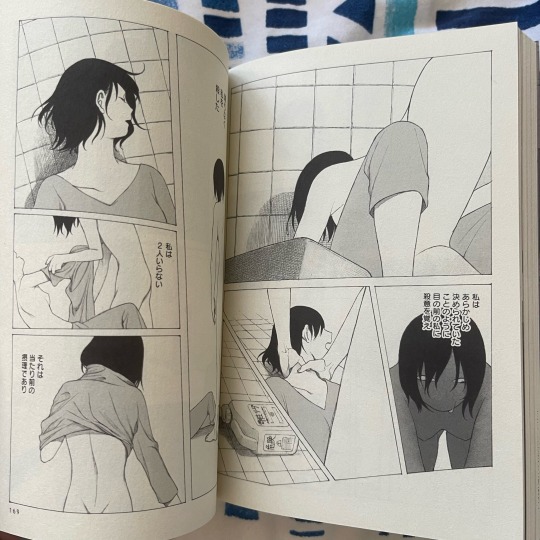
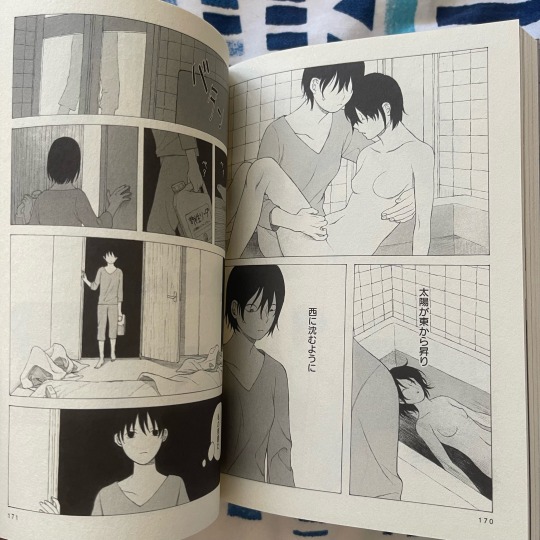
Now burdened with a corpse, our unnamed character goes outside the bathroom and confirms with herself that it's her room and house. But something is bugging her.
"Why did that [me] give up?"

Too sleepy to contemplate further, the woman falls asleep and sees a river of bodies, all replicas of her. She soon wakes from her brief nightmare and goes to dispose of the doppelganger's dead body with the chemicals. However, a familiar scene arises.

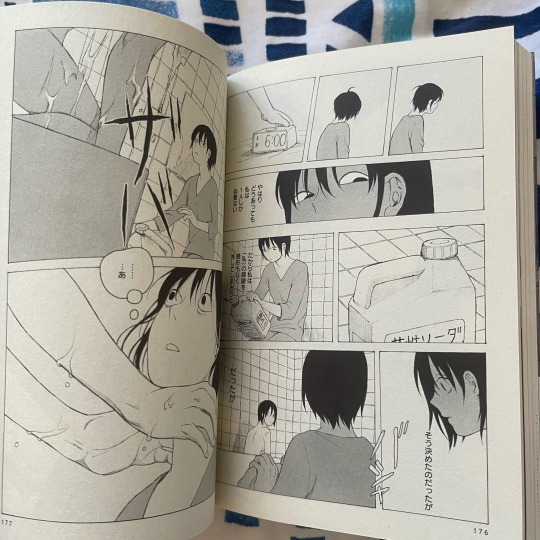

"I remembered my last moments. Us rising in the east and setting in the west will repeat once again."
The story ends with a beautiful shot of sun rays that are illustrated to create an image of them radiating off the woman's back, both figures frozen in time, doomed to repeat everything once again. The same cruel fate awaits both of them, or however many of 'them' there may be.
One of the main captivating points of the story was the revelation of the intention behind the story's title. It's used to perfectly describe a time loop, and is incredibly tasteful. We're introduced to the image of the sun rising and falling from the title page, and are later reminded of its presence at the very end. Even during the story, the woman mentions how her murderous intent stemmed from a desire to adhere to the laws of nature, that being that only one of her should be existing at a time. It's a primal feeling that seems like it came out of nowhere, but is strangely justified in such an otherworldly scenario. The intense and dead-focused facial expressions of her as she chokes her doppelganger really gives you a sense of how deep this emotion runs. It's almost as if it's powering her entire existence, her mind deeming this clone as a threat to her own life. It's such a contrast to the bewildered and helpless expression of the victim, even more effective after the switch occurs.
At the midpoint of the narrative, once the 'original' woman had choked out her copy, she falls asleep and has a brief dream. Although only a page long, it serves the purpose of hinting at the existence of a time loop, an important element for me because it keeps the momentum and mystery running high. The initial murderous intent she felt was replaced by a strong fear, a quick switch in tone as we read on in confusion.
And last but not least, the re-enactment of the initial bathtub awakening scene opens our eyes to Fuyumushi's master storytelling. It all comes full circle in a shocking fashion, how time loop stories should be. I don't have any deep or critical interpretations of the story and any potential messages it may have. For this one, I prefer to bask in the endless awe it brings me every time my mind revisits it. Personally, breaking it down and trying to derive some form of meaning from it dampens my enjoyment of the story, so I choose not to. Sometimes I prefer this approach of consuming stories, especially those that are non-linear, surreal and clearly intend to leave the reader confused and in wonder. All in all, Fuyumushi has been one of my greatest discoveries of 2023. "Sets in the West" is only one story out of twelve that she offers, every single one of them masterpieces in their own right. It isn't an exaggeration when I say some of her short stories are the best I've ever read, not even just from the medium of manga. I really hope that one day, her works will be officially published in English. Until then, I'll continue wishing for it as long as the sun rises in the east, and sets in the west.
Thanks for reading!
0 notes
Text
Dolls and Clones: Dystopias in the Dark
SPOILER FOR BOTH STORIES

Never Let Me Go (Faber & Faber Edition) by Kazuo Ishiguro / AX Vol 152 (April 2023) with cover art by Kouichi Matsuda
What do Kazuo Ishiguro’s “Never Let Me Go” and Nakamura Taichi’s “Doll Thief” (Ningyou Dorobou) have in common, you may be wondering. The two authors that I've chosen for this article can seem a little bit unexpected: an award-winning and renowned Nobel Prize writer and an emerging mangaka who had recently won a rookie award in an alternative manga magazine. Not always the obvious choice of comparison, even more so with the different mediums they both work in. But background differences don't matter, because both of these amazing authors have managed to create dystopias that leave you scrambling in the dark, trying to find your way through the subdued horrors of their worlds.
Final disclaimer before moving on, but this article will be spoiling both stories heavily, so continue reading at your own peril!
Artificial Humans
As you may have noticed from the title, the stories I've chosen deal with issues centred on the existence of artificial humans alongside people. For Ishiguro's novel, they're primarily labelled as 'donors' - clones with no reproductive ability raised and harvested for their organs. For Nakamura's manga, they're referred to as 'dolls', brought up on a farm to be later bought by the rich. In both cases, we see these human reproductions grown, purchased and 'used' - a term that can mean that they either end up dead, or have their purpose reduced to that of a trophy. Either way, they're trapped.
Concerning the ethics of creating and using artificial humans, there is endless discourse on the for and against, a debate which I won't be discussing too much in this article. My main focus will instead be on the storytelling methods of both authors, characterised by an abstinence from exposition until fully necessary. Ishiguro holds out until you are at your most vulnerable, while Nakamura leaves you hanging in shock and disbelief. Sometimes not saying anything is all that needs to be said. Despite their differences in the ways they utilise, or abandon, exposition, you're left in a constant state of confusion. Where is everyone? Who are these artificial beings? Why are they made, and what does the world outside the prison wall look like?
Never Let Me Go: Betrayal


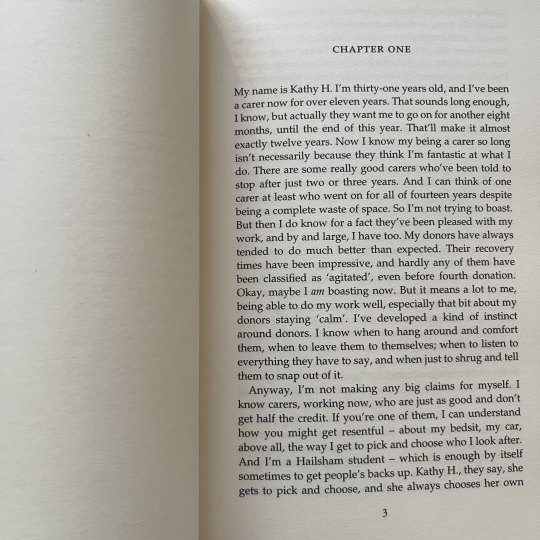
I'll begin first by talking about "Never Let Me Go" (2005), one of Ishiguro's most well-known books that was also adapted into a live-action film (2010) by director Mark Romanek. I personally haven't watched the movie, but the novel has already given me enough heartbreak for a lifetime.
To briefly summarise the plot, we follow narrator Kathy as she recounts her upbringing in Hailsham, a school for clones. As the story progresses, we're thrown more and more clues on how the world outside operates and why they're all forced to isolate themselves from the 'normal' people. It's a coming-of-age story that becomes all the more devastating as Ishiguro drops a shocking twist after hundreds of pages of teasing and holding out on the truth.
Plot aside, I want to discuss Ishiguro's control of tension and 'abstinence from exposition'. Yes, there is exposition throughout the book, but never enough to properly fill you in on the world and what makes it a dystopia. Only hints, only clues, only little nudges in the right direction for most of the book. Kathy's perspective and view of her surroundings is naturally limited, which acts a perfect vantage point that unites us with her confusion and frustration. More clues are dropped on various terminology like 'donors', 'carers' and 'completion', all pointing towards an imminent doom for the clones. You either 'complete' and have your organs harvested, or you become a 'carer', only briefly delaying your 'completion' as you tend to other 'donors'. It's a heart-breaking system that is only made all the more emotional as we see Kathy and her friends praying to false hopes, desperately searching for a way out and another purpose for their lives. Nothing is ever revealed to us clearly by Ishiguro for most of the book; we only know what the clones know. He abstains from revelations until we really need it, finally dumping everything we want to know at the end of the book. It’s this constant nudging and teasing that Ishiguro uses to keep us at an arm's length from the truth, but is still able to simulate the feeling of being lost in the dark.
The Soul
The Gallery is a museum of art pieces and creative works done by clones that are displayed to the outside world. A rumour surrounds it: some believe clones are spared from being harvested if their creative work shows they have a 'soul'. This soul is the equivalent to humanity, and our main couple endeavour to create works that show 'true love' in hopes of both being spared. They pin their entire future on their success in showing their 'humanity' through art, merely a false hope.
But what comes of it? What happens after they spend their entire lives governed by this rumour, and finally come into contact with the one that will reveal all, the Madame?
After going the entire book without understanding much about the world, Ishiguro uses the Madame to drop a lengthy exposition that details everything about the dystopia. Clones had revolutionised medicine after a war. Normal people wilfully ignored the inhumane treatment of clones. Hailsham was actually a pro-clone institution, aiming to use The Gallery to show whether the clones even had a soul to being with. And finally, a recent scandal involving clone ethics had evaporated all support for Hailsham and anyone else who was pro-clone. All of this information triggers intense emotions as we try to process everything, but satisfaction is also felt at finally understanding everything about the dystopian world of "Never Let Me Go". But things don't end there; it's not as easy as that. Their deaths are still imminent, but what makes it even worse are the subtle implications of the Madame's tone.
"You poor creatures."
Her mission was to show that the clones had humanity, but her way of talking, specifically this repeated term of "creatures", suggests that she never could bridge the gap between viewing them as clones and seeing them as humans like her. Their supposed saviour still couldn't fully embrace them as humans. That is the betrayal that had broke me the most: the Madame's hypocrisy of failing to see them as humans herself.
Looking back, you realise how patient Ishiguro must have been in writing "Never Let Me Go". I would pin 80% of the novel being a slow-burn, with the true nature of the dystopia only being revealed at the very end. And even then, he still manages to prevent the long-awaited exposition from becoming a superficial info-dump by showcasing the hypocrisy mentioned above. The Madame was a more subtle embodiment of it, but her assistant Mrs Emily had much more to say. I'll end this section with a passage from her below because I feel like it very much speaks for itself.
“[The Madame] has given everything for you. She has worked and worked and worked. Make no mistake about it, my child, [the Madame] is on your side and will always be on your side. Is she
afraid of you? We’re all afraid of you. I myself had to fight back my dread of you all almost every day I was at Hailsham. There were times I’d look down at you all from my study window and I’d feel such revulsion . . .”
She stopped, then something in her eyes flashed again.
“But I was determined not to let such feelings stop me doing what was right. I fought those feelings and I won. Now, if you’d be so good as to help me out of here, George should be waiting with my crutches.”
Doll Thief: A Short Masterpiece
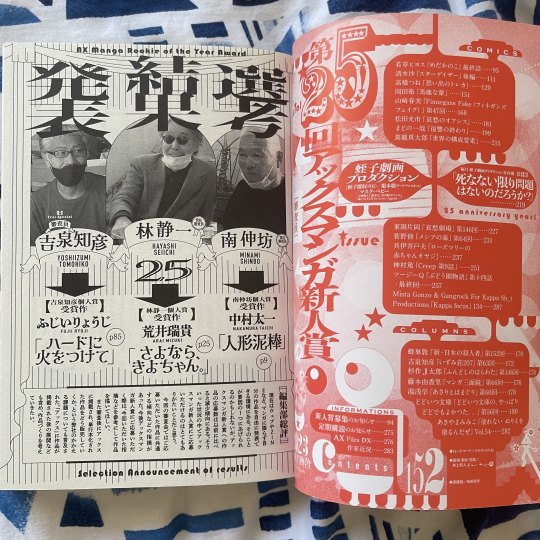



Beginning pages of Nakamura Taichi's "Doll Thief"
AX issue 152 revealed the rookie award results for the year of 2023, judged by Yoshizumi Tomohiko, Hayashi Seiichi and Minami Shinbo. I'm very familiar with Hayashi's work in Garo, and know of Minami's contributions to the same magazine as an editor, illustrator and essayist. Unfortunately, I don't know much about Yoshizumi. Each of these judges picked a work they thought best deserved to win, and Nakamura's 16-page story was selected by Minami as a recipient of the prize. It's very much shorter in length than Ishiguro's novel by a long mile, but Nakamura still manages to instill the same feeling of being left in the dark. He uses the same method of refraining from any exposition or direct explanations of the world, and in doing so heightens the impact of the climactic and bone-chilling ending. But first, before any comparisons, I'll have to explain the plot.
"Doll Thief" opens with a shot of a farm with a sign titled "National Doll Manufacturing Farm". We follow a few of these dolls playing in a field, each of them dressed up in full pyjama-like costumes featuring different animal ears. In the distance, an unnamed man spies on one of the dolls named Nebosuke, and eventually makes his move, capturing him successfully. The other dolls are left confused after noticing his disappearance. At this point in the story, minimal dialogue is used, and your attention is focused on this strange setting. Farms, dolls, people in costumes, animal ears, thieves. You're thrown straight in with no explanation, a similarity with the start of Ishiguro's "Never Let Me Go".


Nebosuke eventually wakes up and demands to be freed, obviously being denied by the thief. He ominously asks the thief:
"You know you're a [Doll Thief] right? Where are you stealing me off to?"
Does this imply that there are many doll thieves in this world? How common is it for dolls to be stolen from their farms, and what do they do with them? The thief very quickly answers that his motivation is money; he already has a buyer lined up for Nebosuke. At that comment, Nebosuke asks whether he'd sell for a lot of money, opening up some opportunity for the thief to tell us a little bit more about the world.
"This country is shit. It's a rural country, but the doll manufacturing capabilities here are outstanding. Among the foreign rich, owning a doll is a symbol of status. They'll spend any amount of money to get their hands on one."

From that brief paragraph explanation, our mind immediately starts searching for other possibilities on what these rich do with the dolls. We are never told anything else other than their being a symbol of status. Nor are we told how the dolls are manufactured and how 'human' they are, though we can gather that they're extremely well-made from Nebosuke's mannerisms and qualities. Much like Ishiguro, Nakamura keeps us in the dark, to great effect.
"All the same, I'm going home."
Immediately after hearing the thief's explanation, Nebosuke stands and responds with that line. The next scene below pictures his suicide, a series of panels surveying his remains against a desolate and empty road. The silence of these pages hit hard, especially with how quick the death is portrayed.
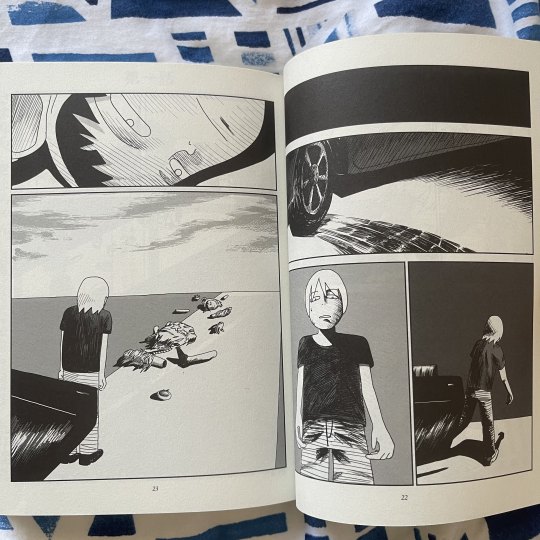
Trophies
Keep in mind that "Doll Thief" is a measly 16 pages, but is still able to tell you so much about its world. From the plot summary, the similarities between Nakamura's and Ishiguro's storytelling methods are clear. Both leave you alone in their worlds and let you figure out the rest with minimal assistance until it's fully necessary. The thief's detail on the value of dolls as symbols of status open up so much potential for the world, and yet never divulges any further than what's needed. We're left wondering if dolls like Nebosuke are displayed as trophies, or if there's something more sinister that they're used for.
Which brings me to my next point, that being the dystopian aspect of this world. At first, calling the world of "Doll Thief" a dystopia may seem a little off, but if you compare the use of these artificial humans with the 'donors' in "Never Let Me Go", it becomes a little easier to grasp. Both artificial entities are grown/created, but instead of being harvested like the 'donors', the dolls are sold off to rich buyers. The thief's kidnapping implies Nebosuke is being sold in an illegal market, but their purposes still remain the same whether they're sold legally or not: as trophies. The other dolls were seen playing quite happily at the start of the story, a parallel with the seemingly normal school life and childhood of Kathy and her friends. The stages from birth to cultivation to 'ripeness' remain the same for both stories, both told in a way that culminates in impactful and emotional endings. And it's these two oppressed and trapped groups of artificial humans that bear their futures being stunted by the human society that governs them.
Although Nakamura shares similarities with Ishiguro's in media res and his minimal exposition, he holds one difference. The ending of "Doll Thief" is completely silent. No final exposition like the Madame's is included, and no further details are provided about issues like the ethics and discourse behind doll manufacturing. We are solely left with the thief as he picks up the remains of Nebosuke, the camera zooming out until they become a tiny speck of dust in the distance.

The camera zoom is especially effective in showing how small of a scale this particular story was. This was just one doll kidnapping at one random farm in the middle of nowhere. What else is happening at the farm after the kidnapping? Who runs the farm? What sort of people are the buyers, and what are the politics involved with this business since the doll trade is international? So much more isn't revealed to us, keeping us in the dark, but Nakamura does it so tastefully. Even the thief's facial expression is veiled by the shadows drawn on his face. So much mystery shrouds Nakamura's world, but despite never revealing anymore info, he sticks with it and leaves the reader with a jaw-dropping ending.
Final Thoughts
The comparison between both of these stories came to mind while I was thinking about what to do for my next post. "Doll Thief" had instantly reminded me of "Never Let Me Go", a thought that came up immediately after reading it. The way that the authors leave you confused and in the dark, the way they masterfully tell you about the world without ever revealing too much until it's necessary. For Ishiguro, he lets it build until he unleashes it all at the end. For Nakamura, he prefers the silent route, leaving you to process and think things over yourself. In both cases, the ends of their stories aren't the end of the dystopia. There is infinitely more for the reader to think about after finishing the stories, and it's especially made enjoyable and worth investing your time because of their ability to lure you in. The past, present and future of these dystopias remain a shrouded mystery, but Ishiguro and Nakamura have provided you with the stepping stones necessary to really think about how expansive their worlds can really be.
Thanks for reading!
0 notes
Text
The Heta-Uma Appeal

Garo 1982 September Issue with cover art by Yumura Teruhiko
Heta-uma. 'Heta' as in 'bad', 'umai' as in 'good'. Not officially recognised as an art movement, the wave of manga/art/illustrations that kicked off in the 70s were seen as being "so bad it's good". There are a number of different ways to describe heta-uma, with terms like "unskilled" and "ugly" being used to categorise the rough look of the art. Check out this highly detailed and informative article from Sabukaru for more on its history!
If you're wondering who pioneered the craze and led the charge, look no further than three artists deemed to be the most influential and notable: Yumura Teruhiko, Ebisu Yoshikazu and Takashi Nemoto. Garo was a platform that allowed these artists to spread the name and fame of their crude and raw drawings, often featuring gritty and vulgar subject matter. Heta-uma is a style that rejects the norm and pushes outside the box for new ways of expression, going against standards to evoke new reactions in readers. It aims to leave you laughing, gagging in disgust and everything in between with its sheer variety of storytelling. You can find gag manga, comedic shorts and satire. You can find political and social commentary veiled underneath raw and seemingly shallow drawings. It's a style that I honestly took me awhile to get into, but my appreciation slowly began to accelerate as I dived into alternative manga, especially mangaka like Ebisu.
Ebisu Yoshikazu: First Exposure
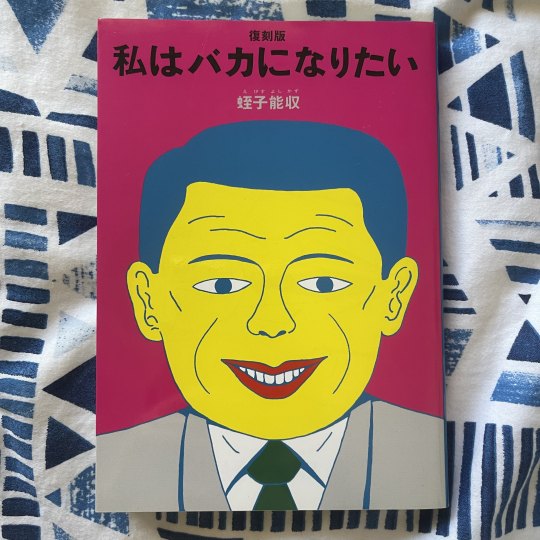
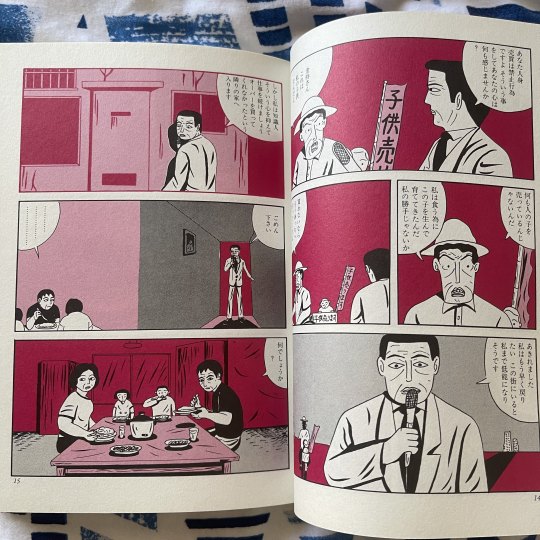


My very first read from Ebisu was a book titled "I Wish I Was Stupid" (Watashi wa Baka ni Naritai), now being released in English by Breakdown Press, an extremely exciting occasion for alternative manga fans. As far as I know, there are few heta-uma mangaka with an official English book, one being Hanakuma Yuusaku with his "Tokyo Zombie" published by Last Gasp in 2008. Takashi Nemoto also had his "Monster Men: Bureiko Lullaby" published in English by Picture Box in 2008. At the moment, Ebisu's "The Pits of Hell" by Breakdown Press is also being reprinted, so I'd hope that demand is high enough for more heta-uma exposure to the English market. There are also alternative manga anthologies like "Ax (Vol 1): A Collection of Alternative Manga", "Sake Jock", and "Comics Underground Japan" that feature heta-uma mangaka and artists like Suzy Amakane and Carol Shimoda amongst others.
But back to Ebisu. I was again exposed to his works via a haul video by Shawn from Japan Book Hunter, and the cover of the manga was enough to get me interested. The book is raw, disgusting, incredibly vulgar and in-your-face with its crazy drawings on confronting subject matter. It blends dark humour with satire on Japanese society extremely well, all supported by rudimentary character designs of salarymen, housewives and naïve children. I loved the weirdly random and surreal settings that feature UFOs flying in the sky, coupled with the desolate backgrounds that emphasise the other-worldliness of Ebisu's work. Its content is extreme, and it left such a lasting impression on me that I had to explore further into the world of heta-uma. I picked up "The Pits of Hell" after that, and am definitely planning to get more Ebisu books in the future.
AX Magazine: A Bigger Picture
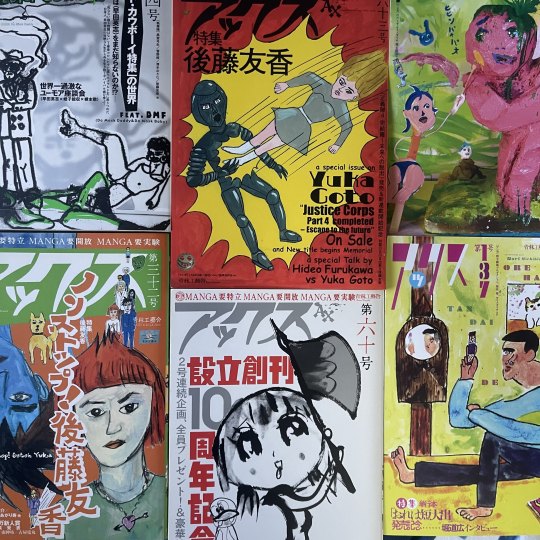
Assorted AX issues featuring heta-uma artists Takashi Nemoto, Goto Yuka, Shiriagari Kotobuki, Family Restaurant and Hori Michihiro
After discovering Ebisu, I had bought myself a whole stack of AX issues, opening up a whole new world of more contemporary heta-uma. This is where I became addicted to artists like Goto Yuka, Shiriagari Kotobuki and Family Restaurant, all centred on more a more comedic/gag style of manga. I still have a long way to go in terms of reading up on all the wonderful heta-uma out there, so I would say I'm still only on the first couple of steps in. One of my favourite heta-uma works that I'm still reading at the moment is Goto's "Justice Corps" (Seigitai), a gag manga following a group of vigilantes fighting to protect the city from monsters and villains. It's a pretty simple premise, but the slapstick humour combined with very rudimentary drawings gives off a nostalgic kids-show vibe. Addicting, straightforward and fun.



Justice Corps vol 1 by Goto Yuka
Shiriagari's "Jacaranda" is another amazing story that follows the violent and chaotic destruction of a city and its subsequent rebirth. The manga begins with a woman on a train brutally beating an old man for accidentally leaning on her shoulder as he struggles to stay awake. Nobody tries to do anything to help, a common critique of passivity in Japanese society that you can find in lots of other manga. Over the course of the story, the city is ravaged by a giant Jacaranda tree that sprouts and destroys the entire landscape, massacring the people around it as buildings topple and fires burn. The art is intense and the civilian deaths are brutally depicted through most of the book. Though, the end result is that of a blooming Jacaranda tree that towers over the city, hailed and prayed to by the survivors. There is little dialogue with most of the sound dominated by screams and onomatopoeia, but Shiriagari's raw and rough art style very much lends to a violent story like this. You can interpret the narrative in many ways, with one observing the first event of the woman's violence on the train as a karmic catalyst to the Jacaranda sprouting. This book is a good example of how the heta-uma style can also lean towards quite sincere and more serious works, a great display of versatility.




Jacaranda by Shiragari Kotobuki
Although, I must say that not every heta-uma work I've read is a favourite for me. "Jacaranda" is, in my opinion, an amazingly raw and hard-hitting work, but Shiragari's "Twin Adults" (Futago no Oyaji) series is very much a hit or miss. You can find individual chapters throughout many of AX's early issues, and there are also tankobons that collect all the stories into one book. The series features two twins arguing and playing, both up to whatever antics they may be up to, but not many of them land for me personally. On a different topic, Takashi Nemoto's subject matter is also a bit too raunchy for my tastes. I appreciate his art style as a whole and actually really love some of art that don't feature extremely explicit imagery, but the usual abundance of the dirty stuff isn't for me.


Left: Takashi Nemoto page from Garo 1983 April / Right: "Futago no Oyaji" from AX vol 8
The King Terry Obsession: Present Time


Various 1983 Garo issues featuring cover art by Yumura Teruhiko
Yumura Teruhiko. King Terry. Terry Johnson. Flamingo Terry. My current artist obsession. The artist is a man of many names. King Terry is attributed as the founder and pioneer of the heta-uma movement from the 70s and onwards with his "artfully artless" illustrations, a quote from Ryan Holmberg which I find is an extremely fitting description. You can find his article below!
King Terry mainly drew illustrations and has only put out one manga in his career, "Penguin Rice", where he drew the art for a story written by Itoi Shigesato for Garo in 1976. I haven't found a copy of it yet, but my eyes are always on the lookout for it. But for now, I'm satisfied with the various Garo issues he'd illustrated covers for, all of them addicting to look at. Yumura had illustrated all the covers for Garo's 1977 issues, reappearing and staying as the physical face of the magazine from 1982-87. He's an artist that has grown on me over time, and I can't give a clear reason why, but it's very much tied in with my love for alternative manga.
And that's pretty much my experience with the wonderful world of heta-uma. To conclude, I want to have one last section about an event that I feel was an extremely important one for heta-uma and alternative manga fans outside of Japan.
Heta-Uma Mangaro: Le Dernier Cri Exhibition
Le Dernier Cri, a French publishing house headed by Pakito Bolino, is your one-stop destination for underground and alternative art that thrives outside of the mainstream. They sell high quality silkscreen prints, books and posters from many Japanese artists and mangaka, many of whom I've talked about before. In 2014, Bolino and Taco Che owner Ayumi Nakayama curated an extensive collection of works from Japanese artists in the double exhibition "Heta-uma Mangaro", a gallery of 40 years of Garo and heta-uma history. There was a catalogue book released for the event that is long OOP, but I'm still patiently waiting for one to pop up sometime soon. But having such a large event specifically for alternative manga and heta-uma is an amazing feat that I hope will inspire bigger and more frequent exhibitions like these. Thanks for reading!
#manga#hetauma#alternativemanga#manga recommendation#art review#manga art#manga panel#japanese culture#japanese history#contemporaryart
3 notes
·
View notes
Text
My Journey with Garo
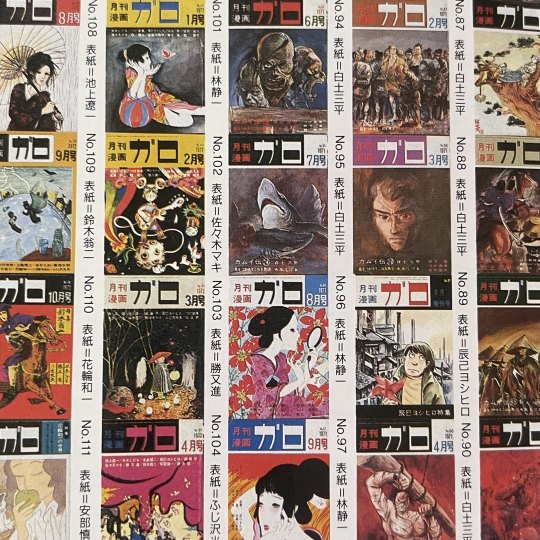
Extract of Garo issue cover art from the Garo Mandala (1991)
It must've been near the end of 2022 when I discovered the treasure trove that is the Monthly Manga Garo, a legendary alternative manga magazine that ran from 1964 to 2002 that thrived against the backdrop of a politically turbulent post-war Japan. In the English market now, we're fortunate enough to be getting a wide variety of translated works from some of the manga greats who had serialised in Garo. From pillars like Tsuge Yoshiharu and Shirato Sanpei to the heta-uma king Ebisu Yoshikazu, you won't ever be bored with the sheer variety of stories, art styles and subject matter that can be seen throughout Garo's lifetime. Pick up any issue and you'll be surprised as to how many types of stories will grace your eyes.
Now back to my personal experience with Garo. I had seen a Garo issue for the very first time through one of Shawn's videos from Japan Book Hunter, a manga plug that I've used for amazing and rare manga that you won't be able to find anywhere except in Japan's jungle of bookstores. His YouTube channel at the time was uploading extremely interesting manga hauls that touched upon a wide variety of lesser-known genres and niches in Japanese comics. There were alternative manga, Shoujo horror, SF, gag and all the other gritty stuff from the wider world of manga outside the usual Shounen Jump. I watched his channel religiously and still look back on some videos to this day, reflecting on how far I've come in learning about manga and manga history. Huge shoutout to Shawn and his store, check him out!
After moving away from the more well-known Seinen and Shounen titles in search of more to explore, my foray into alternative and underground manga was one of the most enlightening experiences in my reading journey. I'd equate my discovery of Garo to my first reads of Borge's short stories, both mind-blowing experiences that have completely transformed my tastes in fiction forever. Garo and my subsequent dives into other alternative manga have now created an insatiable curiosity into what else could be hidden out there in the largely untranslated world of manga. It seems like going backwards in time is the direction I'm taking, but I haven't even scraped the tip of the iceberg yet with Garo, let alone other niches like Shoujo horror and Kashihon. Slowly I'm completing issue after issue, gradually exposing myself to a legendary group of mangaka and artists that have cemented themselves in a magazine that I feel stands the test of time.
At this moment, I have about 40-ish Garo issues on my shelves, and I've read maybe 15 of those. It's a slow reading process, but it's insanely worth it. Each decade is vastly different from the others, so it's extremely fascinating to see the evolution of the magazine over time. For example, starting off in the 60s you have the legendary Kamui-den by Shirato Sanpei, a ninja tale set in feudal Japan that involves social/political commentary on topics like class conflict and oppression. The series was responsible for the birth of Garo because founder Katsuichi Nagai, who I believe was already experienced in the kashihon market, had wanted to give a platform for Shirato to serialize his work. Many stories in the 60s era of Garo were more politically expressive, coinciding with a lot of the unstable politics at the time in Japan. Other mangaka largely present throughout 60s Garo include Mizuki Shigeru, Tsuge Yoshiharu, Nagashima Shinji, Takita Yuu, Tsurita Kuniko and many more.

Various Garo issues from my bookshelf
Then, you move into the 70s. This is where mangaka and artists like Hayashi Seiichi, Tsuge Tadao, Susumu Katsuma and Abe Shinichi start to become more present in the spotlight and appear more frequently in issues. A more surreal and weirder style of stories begin to appear in this decade, marking a key period for Gekiga in my opinion. Personally, when I think Gekiga, my mind goes to people like Hayashi, Tatsumi, Tsuge and Abe, so it's a time that I feel was a very important one for Garo.

Flowering Harbour - Hayashi Seiichi (Garo 1969 May)
The majority of my Garo reads have been towards the tail end of the 60s, with some reads spread throughout the 70s and 90s. Funnily enough, I don't think I have many issues from the 80s. From what I've read from the later decades of Garo though, I've fallen deeply in love. Going from the Tsuges, Hayashis and Mizukis to a whole new world of more contemporary mangaka like Usamaru Furuya, Kawai Katsuo and Maruo Suehiro opened up an even bigger obsession for the magazine. You have an influx of ero-guro (erotic-grotesque) and heta-uma (bad-good) in the scene that introduced a great deal of new names, a lot of whom had also continued into Ax magazine, the spiritual successor to Garo, after the magazine's end. I can make a whole other post on Ax, but that's for another day.

My Youth - Maruo Suehiro (Garo 1983 August)
That about sums up my journey reading Garo from discovery to this current point in time. With 426 issues spanning from the 60s to the early 2000s, I'm not going to run out of issues to read anytime soon. Maybe in a future post, I'll talk more in-depth about specific mangaka and artists that I enjoy. But anyways, thanks for reading my first blog post if you've come this far! Hoping to get out more posts in the future because it really scratches an itch for me when I can express all my thoughts like this in an extended post format.
3 notes
·
View notes
Text
New Beginnings
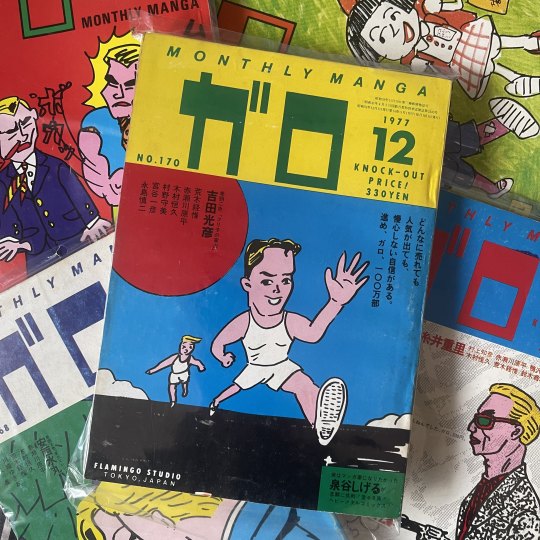
Hey everyone!
I've decided to give tumblr a go in terms of starting my blog, so I'll see how everything works out and if the platform is suitable for me and my posts. No set schedule or plan at the moment for this blog, but I want to just write extended posts on the stuff I read. It'll mainly be manga-related content probably, but anything goes here.
See y'all soon :)
1 note
·
View note